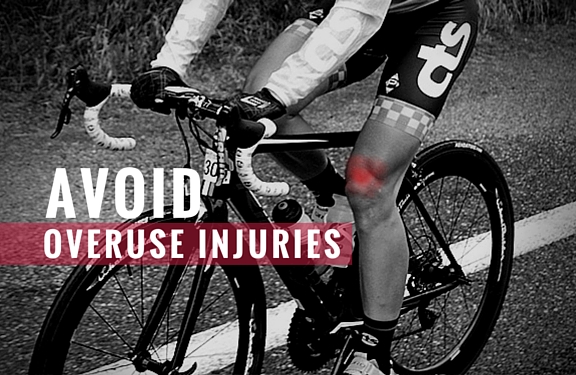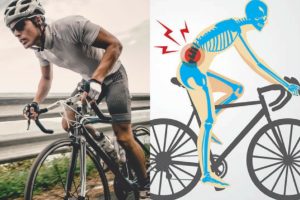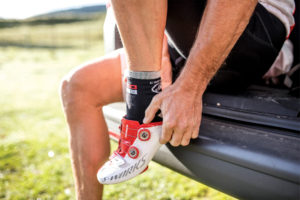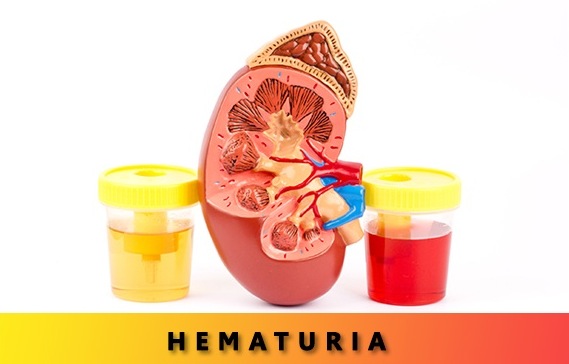As with any form of exercise, cycling does come with a list of common injuries. This article will not focus on injuries that come with crashing, like broken bones and road rash, but instead will focus on common cycling overuse injuries.
These are injuries that can and will (most likely) pop up if you are putting a lot of miles on your bike. Some can come from doing too much too fast, others from improper bike fit, and still others simply from the motion of cycling itself. Although cycling is a low-impact sport, making it great therapy for those who struggle with other injuries, it is a repetitive motion that can cause issues over time.
Whether your looking to treat your cycling overuse injuries or prevent them from occurring in the first place, here’s what you need to know.

Common Cycling Overuse Injuries
Upper Back Pain
Pain in the upper back and neck is one of the most common cycling overuse injuries. A cyclist’s position on the bike is not a natural one, and there is a repetitive sub-maximal loading that can lead to damage. The neck and shoulders are often tense and contracted for extended periods of time, compromising blood flow to those muscles. This will inevitably lead to muscle spasms or stiff and sore muscles over time.
Aside from regular stretching of the shoulders and neck, there are also a couple of exercises you can do while out riding. When you are at a stop light, or stopping for a quick breather, get in the habit of doing some reverse shoulder shrugs. This is simply shrugging your shoulders up towards your ears, then back down towards the ground behind you. Not only does this alternate between contraction and full relaxation, it also combats the hunched over position and helps you avoid the rounding of your shoulders.
Lower Back Pain
Another very common cycling overuse injury is lower back pain. First, you have to understand why this occurs before taking action to fix it. While pedaling, the quadriceps pull the pelvis forward. To keep your body on the bike, your lower back resists that pull. It is an action that is not inherent to the design of your lower back muscles. The result is overworked lower back muscles that may cross into pain.
The best way to both prevent and treat lower back pain from cycling is to work on strengthening your core (transverse abdominal muscles) and glutes. A strong core will activate before any movement takes place in the limbs (like pedaling), and therefore takes the stress away from lower back and works to stabilize the motion.
Calf Muscle Tightness & Strain
Although most your power comes from your quads, your calf muscles also play a major role. Muscle tightness and strain can be a direct result of keeping your foot and ankle stable while pedaling. Improper bike fit, in particular cleat position, may be a contributing factor, but it is a very normal issue to have.
 Achilles and Patella Tendinitis
Achilles and Patella Tendinitis
Another common injury that comes from overuse. However, this can also be caused by a poor bike fit and shoe cleats that are not properly positioned. Achilles tendinitis causes inflammation which in turn will cause you pain in your ankle. If you think this is developing, go easy on your training for a few days. After any exercise make sure you apply ice to the tendon to fight any inflammation you may have.
Hamstring and Quadricep Strain
Hamstring and quadricep strain are most commonly caused by too much too soon. Also, over time, the hamstrings can become shortened and tight from the position on the bike. Regular stretching can both prevent and treat this.
Knee Pain
There are different types of knee pain that can point to different causes and, therefore, different solutions. The four main types of knee pain are anterior (front of the knee), posterior (behind the knee), medial and lateral pain (sides of the knee), and IT band syndrome. Some knee pain is a sign of an improper bike fit, whether it be cleat or saddle position, while some is caused by simple overuse or going too hard too soon. Regular and targeted stretching can be an easy solution.
Treatment and Prevention
Stretching
The most important thing for cyclists, and athletes in general, is to have a healthy range of motion and flexibility to move freely and efficiently. Stretching can aid in aligning the thick and thin muscles back into their ordered state after movement, as well as remove the lactic acid buildup that causes soreness. Flexibility, or rather inflexibility, can lead to unbalance in the body and even cause the body’s structure to move out of alignment. Failing to properly stretch and maintain flexibility can not only affect you performance, but it will inevitably lead to injury and discomfort.
Strength Training
A common problem with cyclists is muscular imbalance. Some muscles become strong, while others are too weak to keep things balanced. By strengthening your muscles and connective tissues with strength training, you can keep your body balanced and even avoid some overuse injuries altogether. It can also help you maintain proper posture on the bike, as a strong core can keep your back nice and straight.
Bike Fit
Getting a proper bike fit is well worth the investment, or at least taking the time to fine tune things yourself. Getting everything adjusted just right for you will ensure you will be comfortable on the bike. You will be more efficient and have a higher degree of power and endurance. It can be overwhelming when you think about saddle height and angle, cleat position, handlebars, and so on, but it is worth taking it one piece at a time. It will lower the risk of developing any injuries associated with an improper bike position.
 Some of us have had that amazing workout, where we’ve challenged ourselves by increasing the volume or intensity of our rides and come out victorious. Then, as the day passes and we use the restroom we realize that we have blood in our urine. Alarmed, we begin to assess ourselves for any signs or symptoms we may have missed leading up to this event. However, this pathology is common in endurance athletes and typically presents itself with no symptoms. Research has shown this usually happens when either the duration or intensity of a workout has increased significantly. In addition, in a sport such as cycling, cyclocross, or mountain biking the genitourinary area can be affected due to the constant pounding on our saddle during our rides.
Some of us have had that amazing workout, where we’ve challenged ourselves by increasing the volume or intensity of our rides and come out victorious. Then, as the day passes and we use the restroom we realize that we have blood in our urine. Alarmed, we begin to assess ourselves for any signs or symptoms we may have missed leading up to this event. However, this pathology is common in endurance athletes and typically presents itself with no symptoms. Research has shown this usually happens when either the duration or intensity of a workout has increased significantly. In addition, in a sport such as cycling, cyclocross, or mountain biking the genitourinary area can be affected due to the constant pounding on our saddle during our rides.